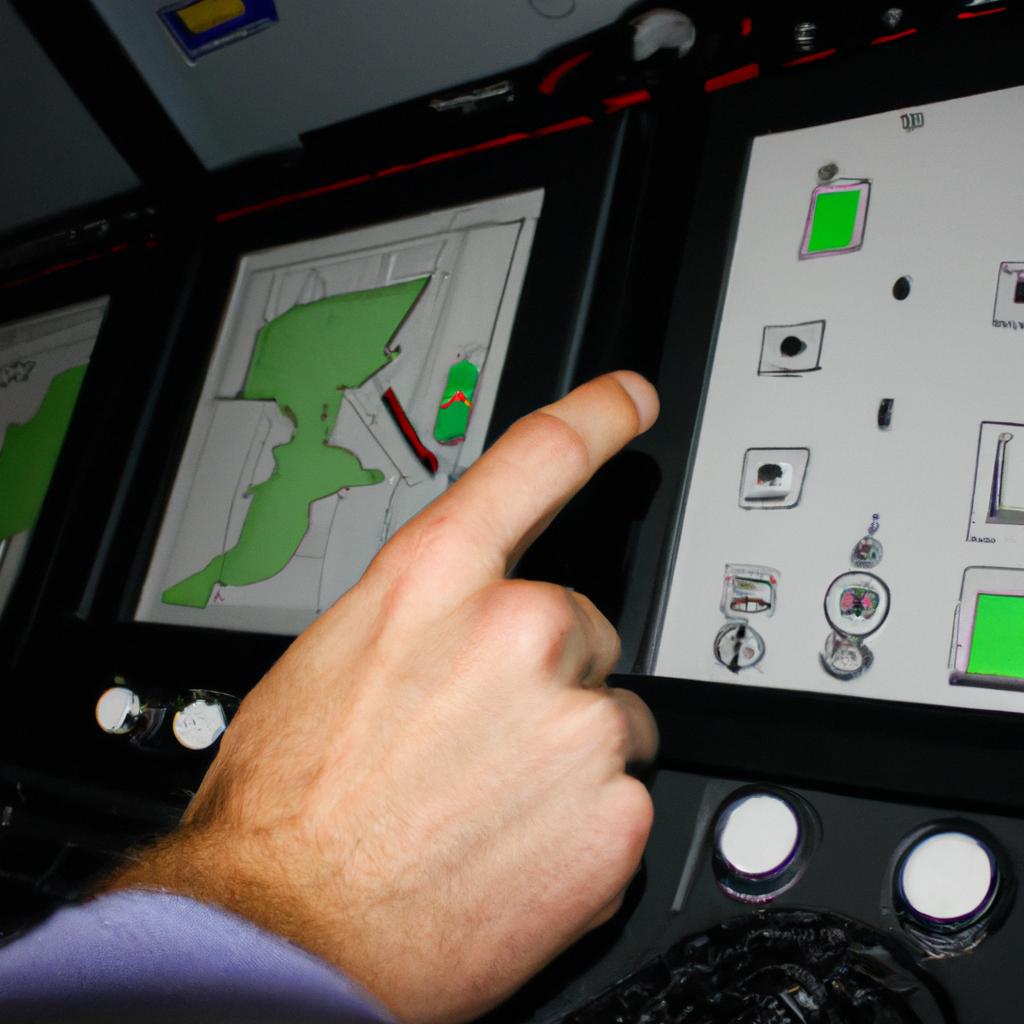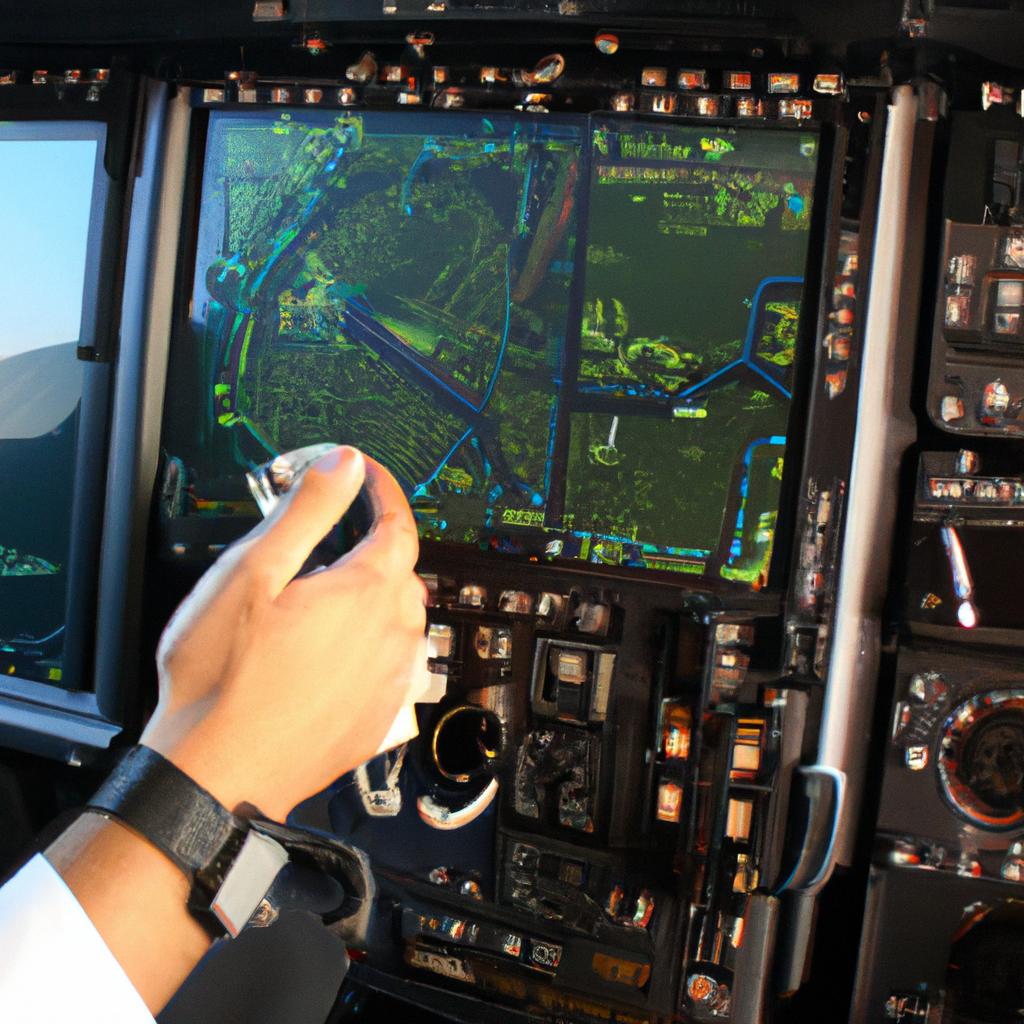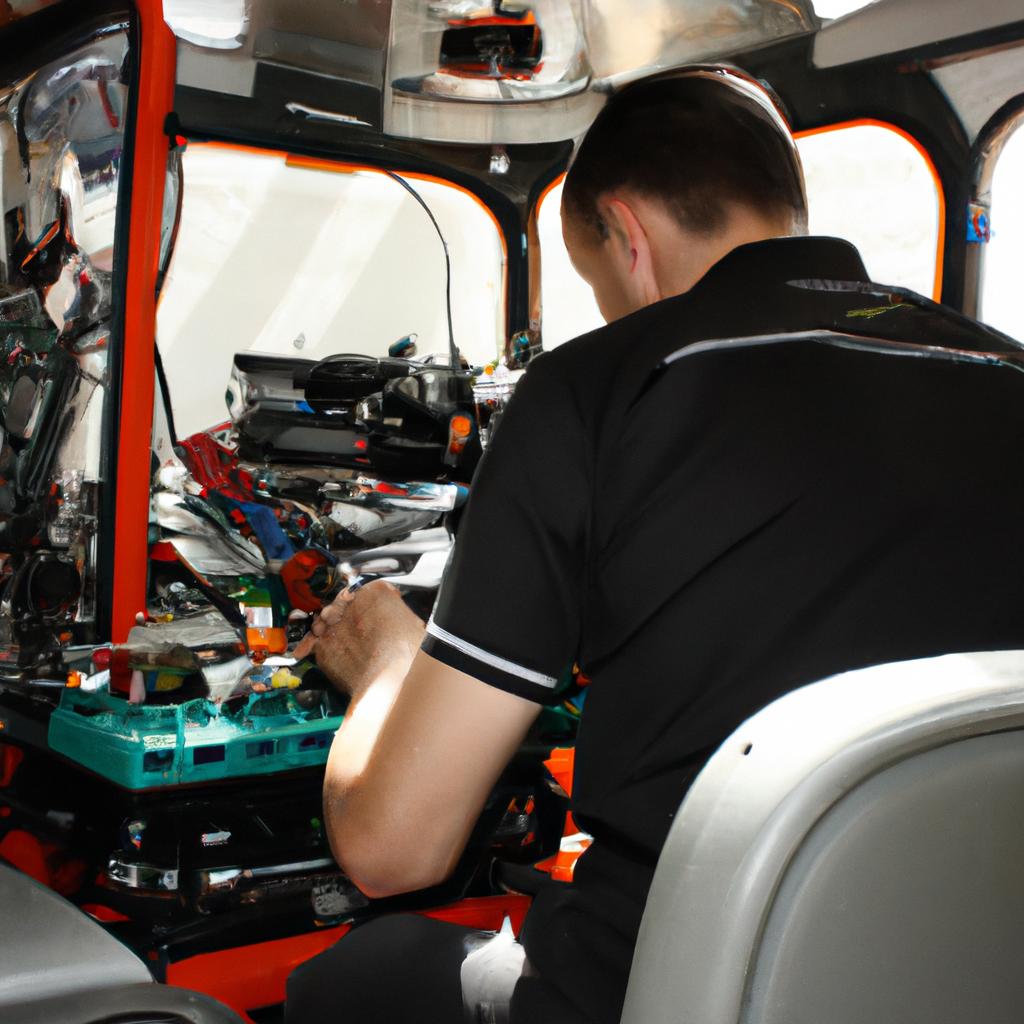Air Data Computers (ADCs) play a crucial role in aerospace and defense applications, providing accurate and reliable data for avionics systems. These sophisticated devices are responsible for collecting various air data parameters such as altitude, airspeed, angle of attack, and rate of climb or descent. In turn, this information is used by flight control systems to ensure safe and optimal aircraft operation. For instance, imagine an airliner cruising at 30,000 feet with ADCs constantly monitoring the surrounding atmospheric conditions. They detect changes in air pressure and temperature to calculate true airspeed, allowing the autopilot system to make necessary adjustments for efficient fuel consumption.
The rapid advancement of technology has led to significant enhancements in ADC capabilities over the years. Modern ADCs incorporate cutting-edge sensors, advanced algorithms, and robust processing power to deliver precise measurements even in challenging environments. This comprehensive guide aims to provide an in-depth understanding of ADCs’ principles of operation, their integration into avionics systems, and their significance within the aerospace and defense industries. By exploring key features like redundancy mechanisms, fault-tolerant designs, and calibration techniques employed in these instruments, readers will gain valuable insights into how ADCs contribute to ensuring flight safety and performance optimization. Additionally, this article will also discuss the various types of ADCs used in different aircraft platforms, including commercial airliners, military fighter jets, and unmanned aerial vehicles (UAVs). It will delve into the differences between analog and digital ADCs, highlighting their advantages and limitations. Furthermore, the guide will touch upon the importance of regular maintenance, calibration procedures, and troubleshooting techniques for maintaining the accuracy and reliability of ADCs.
In addition to their role in flight control systems, ADCs are also instrumental in providing crucial data for weather monitoring, air traffic management, and mission planning purposes. Their ability to accurately measure air density and temperature helps meteorologists forecast weather conditions more precisely. Moreover, ADCs aid air traffic controllers by providing real-time airspeed information for safe separation between aircraft during takeoff, landing, and en-route phases. In military operations, ADCs enable fighter pilots to make split-second decisions based on accurate air data measurements during combat scenarios.
As technology continues to evolve at a rapid pace, it is expected that future ADC designs will incorporate even more advanced features such as artificial intelligence algorithms for predictive maintenance and adaptive control systems. This guide aims to equip readers with a comprehensive understanding of the principles underlying these sophisticated devices while highlighting their critical role in aerospace applications. Whether you are an aviation enthusiast or a professional working in the aerospace industry, this article serves as a valuable resource for exploring the world of Air Data Computers.
What is an Air Data Computer?
Imagine a commercial airliner soaring through the sky at 30,000 feet. The passengers are unaware of the crucial system on board responsible for accurately measuring and computing vital flight parameters such as airspeed, altitude, and angle of attack. This essential component is known as the Air Data Computer (ADC). In this section, we will delve into the intricacies of ADCs in aerospace and defense applications.
To begin with, let us explore some key functions performed by the Air Data Computer:
- Calculating Airspeed: One of the primary tasks of an ADC is to measure and compute airspeed. By analyzing inputs from various sensors like pitot tubes and static ports, it determines the velocity at which an aircraft moves relative to the surrounding air.
- Determining Altitude: Accurate altitude measurement is critical for safe navigation during flight operations. An ADC employs pressure sensors coupled with atmospheric models to calculate precise altitudes above mean sea level.
- Estimating Angle of Attack: Another significant parameter monitored by an ADC is the angle of attack (AOA), which denotes how effectively an aircraft’s wings generate lift. Through sophisticated algorithms incorporating data from multiple sources, including AOA vanes or probes, ADCs provide pilots with real-time feedback on this vital factor.
- Detecting Temperature: Understanding ambient temperature plays a pivotal role in aviation systems’ performance evaluation. ADCs incorporate temperature sensors that enable them to calculate certain aspects like true airspeed more accurately.
Let us now examine a table showcasing some typical specifications related to advanced Air Data Computers used in modern aerospace technology:
| Specification | Description | Importance |
|---|---|---|
| Measurement Range | The operating range within which measurements can be made | Ensures functionality under diverse conditions |
| Accuracy | Degree of precision in determining parameters | Crucial for reliable flight information |
| Redundancy | Presence of backup systems for enhanced reliability | Ensures safety in case of component failure |
| Data Output | Format and protocols used to communicate information | Compatibility with other avionics equipment |
In conclusion, the Air Data Computer is a vital avionic device responsible for calculating essential flight parameters. By accurately determining airspeed, altitude, angle of attack, and temperature, ADCs provide pilots with critical data required for safe and efficient flying. In the subsequent section, we will explore the significance of these devices in aerospace and defense applications.
[Transition sentence: Now that we have established an understanding of what an Air Data Computer entails, let us further delve into its importance within aerospace and defense operations.]Importance of Air Data Computers in Aerospace and Defense
Air data computers play a crucial role in the aerospace and defense industry, providing vital information for flight operations. To illustrate their significance, let us consider a hypothetical scenario where an aircraft is equipped with an air data computer malfunctioning during a critical mission. Without accurate and reliable airspeed, altitude, and other essential measurements provided by the air data computer, pilots would face significant challenges in ensuring safe navigation and control of the aircraft.
To better understand the importance of air data computers in aerospace and defense, the following bullet points highlight some key aspects:
- Safety: Air data computers are integral to aviation safety by continuously monitoring critical parameters such as airspeed, altitude, vertical speed, and angle of attack. Accurate readings enable pilots to make informed decisions regarding flight maneuvering, avoiding potential hazards or dangerous situations.
- Performance Optimization: By analyzing real-time inputs from various sensors on board the aircraft, air data computers can calculate important performance metrics like true airspeed and Mach number. This information aids in optimizing fuel consumption, engine efficiency, and overall operational effectiveness.
- Navigation Assistance: Air data computers provide precise positional information through systems like Inertial Navigation Systems (INS) or Global Positioning Systems (GPS). These systems rely on accurate air data inputs to determine the aircraft’s position, aiding navigation during both normal flights and complex missions.
- Fault Detection: Air data computers incorporate built-in diagnostics capabilities that monitor sensor health and detect any anomalies or failures. Timely identification of faulty sensors allows for prompt maintenance actions to be taken before they compromise flight safety or accuracy.
Furthermore, it is worth mentioning that air data computers facilitate seamless integration with other avionics systems through standardized protocols and interfaces. Their ability to communicate with autopilot systems, flight management systems, weather radar displays, among others enhances overall operational efficiency.
With an understanding of the importance of air data computers established above, the subsequent section will delve into the working principle of these critical avionics components. By examining their underlying mechanisms, we can gain further insight into how air data computers gather and process crucial flight data to ensure safe and efficient aircraft operations.
Working Principle of Air Data Computers
The Importance of Air Data Computers in Aerospace and Defense
In the previous section, we discussed the significance of air data computers in aerospace and defense. Now, let us delve into the working principle of these complex systems that play a crucial role in ensuring safe and efficient flight operations.
To better understand how air data computers function, let’s consider an example scenario: Imagine you are piloting an aircraft at high altitudes. As you ascend, the outside temperature drops significantly. Simultaneously, atmospheric pressure decreases due to thinner air density. In this situation, accurate measurement of parameters such as altitude, airspeed, and vertical speed becomes vital for maintaining proper control over the aircraft.
Air data computers utilize various sensors to collect data on critical flight parameters. These sensors include pitot tubes, static ports, total air temperature probes (TAT), angle-of-attack vanes (AOA), and more. The collected information is then processed by the air data computer using sophisticated algorithms to calculate essential values like true airspeed, indicated airspeed, Mach number, altitude rate of change (vertical speed), and other necessary aerodynamic quantities.
Here are some key functions performed by air data computers:
- Conversion of raw sensor inputs into meaningful measurements
- Compensation for variations in atmospheric conditions
- Calculation of corrected values based on specific aircraft characteristics
- Real-time monitoring and display of important flight parameters
For a clearer overview, refer to the following table showcasing typical input-output relationships within an air data computer system:
| Input | Processing | Output |
|---|---|---|
| Pitot tube | Pressure measurement | Indicated airspeed |
| Static port | Atmospheric pressure measurement | Altitude |
| Total air temperature | Temperature measurement | True airspeed |
| Angle-of-attack vane | Angle measurement | Angle-of-attack |
Understanding the intricacies of air data computers is essential for ensuring the safety and reliability of aerospace and defense systems. In the upcoming section, we will explore different types of air data computers used in avionics, providing a comprehensive understanding of their unique features and applications.
Transitioning into the subsequent section on “Types of Air Data Computers,” it becomes apparent that there are various approaches to designing these critical components to suit diverse aircraft requirements.
Types of Air Data Computers
Working Principle of Air Data Computers (Continued)
In the previous section, we explored the intricate workings of air data computers (ADCs) in avionics. Now, let us delve further into the various types of ADCs that are utilized in aerospace and defense applications. To illustrate their significance, consider a hypothetical scenario where an aircraft encounters adverse weather conditions during flight.
When faced with turbulent weather, accurate measurements become crucial for pilots to make informed decisions. This is where air data computers play a pivotal role by collecting and processing real-time data from various sensors onboard the aircraft. By analyzing factors such as air pressure, temperature, and wind speed, these sophisticated systems provide vital information necessary for safe navigation and control.
The different types of air data computers can be categorized based on their functionality and complexity:
- Basic ADCs: These entry-level systems perform essential tasks like measuring static pressure and calculating altitude or rate of climb/descent.
- Advanced ADCs: Equipped with additional capabilities, advanced ADCs also account for variables such as dynamic pressure and Mach number while providing more precise information about airspeed.
- Multipurpose ADCs: As the name suggests, these versatile systems offer a wide range of functionalities beyond basic altitude and airspeed calculations. They may include features like angle-of-attack measurement or integration with other avionic systems.
- Integrated Modular Avionics (IMA): IMA-based ADCs consolidate multiple functions onto a single platform, reducing weight, power consumption, and maintenance requirements. These highly integrated systems contribute to enhanced overall performance.
To further understand the impact of ADC technology in aviation, let’s take a closer look at its practical implications:
| Benefit | Description | Emotional Response |
|---|---|---|
| Enhanced Safety | Accurate air data readings enable pilots to navigate through challenging weather conditions safely | Confidence |
| Improved Efficiency | Precise data processing results in optimal flight performance and fuel consumption, leading to cost savings | Relief |
| Increased Reliability | Redundancy features ensure continuous operation even in the event of sensor failures or system malfunctions | Assurance |
| Advanced Decision-Making | Real-time information assists pilots in making informed choices regarding altitude adjustments, speed control, and route optimization | Empowerment |
In conclusion, understanding the types of air data computers helps us appreciate their significance when it comes to aviation safety and efficiency. The ability to gather accurate real-time data is crucial for pilots to make well-informed decisions during adverse weather conditions. With enhanced safety measures, improved efficiency, increased reliability, and advanced decision-making capabilities, ADCs have become an indispensable component of modern avionics systems.
Moving forward, we will explore various applications where air data computers are extensively utilized in aerospace and defense operations.
Applications of Air Data Computers
An important aspect of air data computers in the aerospace and defense industry is understanding the different types available. By examining these variations, one can gain insight into their functionalities and applications.
One example of a type of air data computer is the pitot-static system. This system utilizes pressure sensors to measure atmospheric conditions such as speed, altitude, and vertical acceleration. It consists of two primary components: the pitot tube, which measures dynamic pressure (airflow), and the static port, which measures static pressure (atmospheric). The difference between these pressures provides crucial information for flight control systems.
To further understand the significance of various air data computers, consider the following bullet points:
- Air data computers play a critical role in determining aircraft performance parameters.
- They aid in ensuring accurate navigation and guidance during flights.
- These devices contribute to maintaining optimal fuel efficiency by monitoring variables like true airspeed.
- Air data computers assist in detecting potential icing conditions that could affect aircraft operations.
As seen from this table showcasing some key features:
| Type | Functionality | Applications |
|---|---|---|
| Pitot-static System | Measures dynamic and static pressures | Flight control systems |
| Total Pressure Probe | Measures total pressure | Altitude determination |
| Machmeter | Calculates aircraft’s Mach number | Supersonic flight |
Understanding these types of air data computers helps engineers and technicians make informed decisions when selecting appropriate equipment for specific applications. With advancements in technology, it becomes imperative to explore future trends in air data computer technology.
Future Trends in Air Data Computer Technology
Applications of Air Data Computers in the Aerospace and Defense Industry
Air data computers (ADCs) play a crucial role in the aerospace and defense industry, providing vital information for flight control systems. These advanced avionics devices are used to accurately measure and process various parameters related to airspeed, altitude, vertical speed, angle of attack, and other critical flight data. The applications of ADCs extend across different areas within this industry, ensuring safe and efficient operations.
One notable application of ADCs is in commercial aircraft. Take, for example, a large passenger airliner equipped with multiple ADCs. These devices continuously gather real-time air data from sensors located on the aircraft’s exterior. By processing this information through complex algorithms, ADCs provide accurate measurements that enable pilots to maintain optimal flying conditions throughout the entire journey.
In military aviation as well, ADCs are extensively employed to enhance mission effectiveness. Fighter jets rely heavily on these sophisticated devices to monitor important flight parameters during combat scenarios. For instance, an ADC can aid in determining the best approach angle or allow pilots to execute precise tactical maneuvers based on reliable airspeed readings. This demonstrates how ADC technology directly contributes to enhancing situational awareness and overall operational capabilities.
The significance of air data computers extends beyond aircraft performance alone; they also have significant implications for safety management systems. By integrating ADCs into aviation systems, organizations can capture valuable flight data that helps identify potential risks and mitigate them proactively. Additionally, having access to comprehensive historical records obtained from ADCs enables operators to analyze trends and patterns over time, facilitating continuous improvement initiatives focused on safety enhancement.
To illustrate further how crucial ADCs are in aerospace and defense applications:
- They ensure accurate navigation by providing real-time updates regarding position deviation.
- They contribute to fuel efficiency optimization through precise calculations of wind influence.
- They assist in monitoring engine performance by analyzing pressure ratios effectively.
- They improve pilot decision-making processes by delivering reliable stall warnings and angle of attack indications.
Using ADCs in the aerospace and defense industry not only enhances operational efficiency but also promotes safety, enabling organizations to make informed decisions based on accurate and up-to-date flight data. The table below summarizes some key benefits offered by air data computers:
| Key Benefits | Description |
|---|---|
| Enhanced Flight Performance | Accurate measurements aid pilots in maintaining optimal flying conditions throughout their journey. |
| Improved Tactical Capabilities | Reliable information from ADCs enables precise tactical maneuvers during combat scenarios. |
| Proactive Safety Management | Integration with safety management systems helps identify potential risks and mitigate them proactively. |
In summary, air data computers are indispensable components within the aerospace and defense industry. They contribute significantly to commercial aviation, military operations, and safety management systems. By providing accurate and reliable flight parameters, ADCs enable efficient navigation, enhance mission effectiveness, and support proactive risk mitigation measures. These advanced avionics devices play a crucial role in ensuring safe and successful flights for both civilian and military applications alike
 Louth Online
Louth Online



